The Intel Broadwell Desktop Review: Core i7-5775C and Core i5-5675C Tested (Part 1)
by Ian Cutress on June 2, 2015 7:45 AM ESTProfessional Performance: Windows
Agisoft Photoscan – 2D to 3D Image Manipulation: link
Agisoft Photoscan creates 3D models from 2D images, a process which is very computationally expensive. The algorithm is split into four distinct phases, and different phases of the model reconstruction require either fast memory, fast IPC, more cores, or even OpenCL compute devices to hand. Agisoft supplied us with a special version of the software to script the process, where we take 50 images of a stately home and convert it into a medium quality model. This benchmark typically takes around 15-20 minutes on a high end PC on the CPU alone, with GPUs reducing the time.
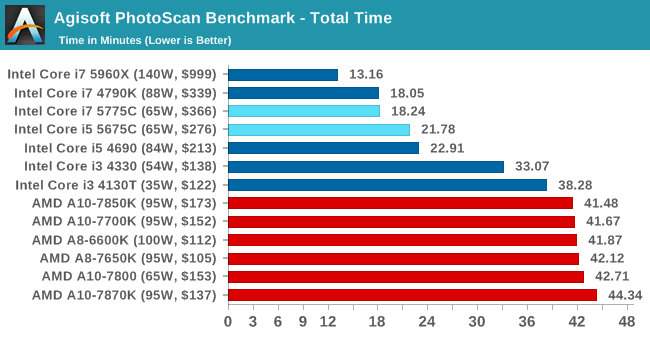
The presence of Crystal Well had a small effect on Photoscan, occurring mostly in the second phase of the calculation which is the one that also has an option to enable the GPU, indicating that memory bandwidth is an potential limitation in that segment.
Cinebench R15
Cinebench is a benchmark based around Cinema 4D, and is fairly well known among enthusiasts for stressing the CPU for a provided workload. Results are given as a score, where higher is better.
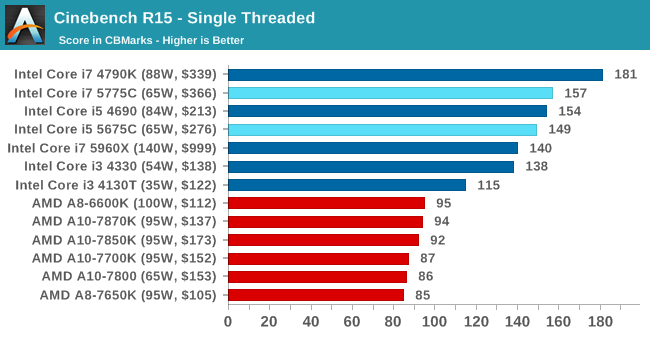
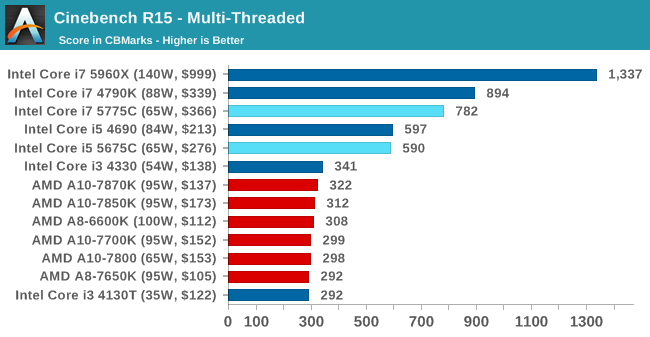
Cinebench is a historically CPU-limited benchmark, and the results show this again here. The fact that the 3.6GHz Broadwell-based i5-5675C performs so closely to the 3.9GHz Haswell-based i5-4690 is a promising sign here, as it means that despite being a mere "tick" in Intel's development efforts, there are tangible IPC increases on the desktop from Broadwell.
HandBrake v0.9.9: link
For HandBrake, we take two videos (a 2h20 640x266 DVD rip and a 10min double UHD 3840x4320 animation short) and convert them to x264 format in an MP4 container. Results are given in terms of the frames per second processed, and HandBrake uses as many threads as possible.
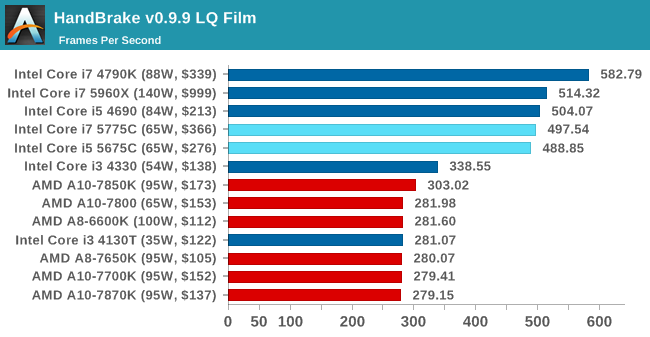

While no obvious improvement was seen in the low quality conversion, the double UHD conversion put the i7 above what was otherwise expected.
Hybrid x265
Hybrid is a new benchmark, where we take a 4K 1500 frame video and convert it into an x265 format without audio. Results are given in frames per second.
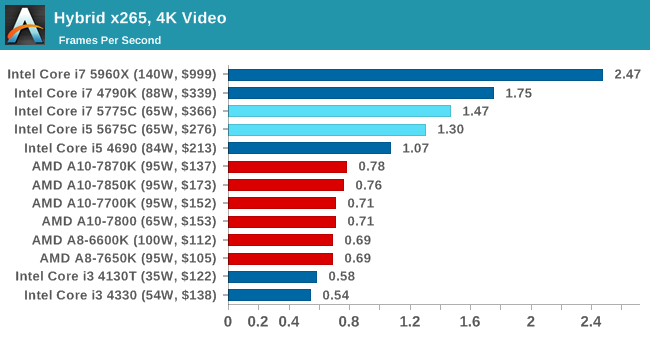
Unlike the Handbrake H.264 tests, the Hybrid x265 tests show a clear uptick in performance on the Broadwell processors. It is not fast enough to catch the i7-4790K and its 4.4GHz turbo clockspeed, but we see the i5-5675C shoot well past the i5-4690 despite the clockspeed deficit. Whether this is due to Broadwell architecture enhancements, Crystal Well acting as an L4 cache, or a combination of the two is difficult to determine, but the end result is substantial.










196 Comments
View All Comments
Taneli - Tuesday, June 2, 2015 - link
So how does it compare to 4770R?IUU - Tuesday, June 2, 2015 - link
Good , very good . Now after they have succeeded in this exercise, that is , showing they can build decent igpu, they can finally proceed to the real goal. Make a little bit weaker processors with the same igpu for real laptops, where portability but performance as well are needed at the same time.Then, throw away the burden of the i-gpu part for real desktop parts and complete the desktop series with 80 100 and 130 watts models.
Trying to persuade customers that from now on this is the high end is not going to work. The desktop
or desktop like derivatives should be at the front end of new computer challenges, none of which is
what we describe today as consumer needs(with the exception of gaming of course which admit it or not will always be one of the most demanding software).
Consider that pattern recognition(be it sound video or logic-language) will demand a lot of and parallel processing. Trying to push it as a network based service will not succeed at least as it is
envisioned right now. A significant part of it should be done locally. Now take this advice and conquer or abandon it and fail lol...
bill.rookard - Tuesday, June 2, 2015 - link
I'm not sure that they've proven they can build a decent iGPU. The whole point of integrated graphics is to provide an affordable solution with 'good enough' performance. While they have certainly hit the 'good enough' performance from both a CPU and GPU point of view, they've entirely missed the 'affordable' part of things. For the price of a single Intel CPU, you can almost get an AMD -system- which (while about 10% slower on average) is no small matter.Truth is (as pointed out) you can get an AMD chip with a $100 discrete graphics card which would blow either of the iGPUs away.
mrdude - Tuesday, June 2, 2015 - link
That's the issue both AMD and Intel have had with respect to their iGPUs. Once you've dedicated enough of the die to GPU transistors and skirted around the memory bottleneck (at least for Intel), you end up with a product that, while offering decent GPU performance, is horrendously overpriced for what it offers. Outside of niche scenarios, these things just don't make much sense given just how performance even cheap discrete GPUs can offer.I'd like to see what Intel's margins are on these parts and how much the eDRAM adds to the overall cost of the product. If yields are good and prices aren't much higher, I'd love to see Intel 'bite the bullet' in order to replace the entire product portfolio top-to-bottom. They'd benefit massively from it with respect to market share and being taken seriously with their gaming endeavor.
Unfortunately, I don't think Intel is willing to eat lower margins and a dip in profits for a long term gain, even if it would see a bucking of the current dip in sales with uptick in systems sold.
Refuge - Tuesday, June 2, 2015 - link
They have the best margins in the business.But of course they wont. Why lower prices, make less money now, kill AMD more, and then make more money later possibly if you don't lose out on some BS legal battle over having no compitition. Because it will happen, you know it will.
When instead you can continue to enjoy your large margins with minimal griping because the blame is being split between Intel's greed and AMD's inability to compete. Watch them die slowly, make more money while doing it. They control this playing field, why rock the boat when it is more profitable than it should be already?
Kjella - Tuesday, June 2, 2015 - link
And an Intel chip too, I wonder who are these people who'll pay $276-366 for something that'll get totally trashed by a $64 G3260 + $2-300 discrete graphics card. I guess the target market is AIOs that value style and low power consumption over performance and cost. If you look at their laptop prices, they're the same. So I'm guessing Intel didn't want manufacturers underclocking the 65W chips and using them as cheap 47W laptop chips. And the AIO makers wouldn't like Intel releasing a socketed chip cheaper than the identical BGA chip so the price is set with no grounding to reality in the desktop market.vision33r - Tuesday, June 2, 2015 - link
Majority of people can use G3260 + a decent vid card and have no clue it's a cheap underclass cpu. i5 and i7 are just marketing ploy for clueless people to buy the top level even though they don't know where the performance bottlenecks really are.Notmyusualid - Thursday, June 4, 2015 - link
You know, two of my brothers have i5 CPUs, and my i7 utterly trounces them, in every way. I was expecting the difference to be small, but oh no, for example, one brothers' 3230M does wPrime in < 19s, my i7 < 8s.This speed difference is reflected in the way the PCs 'feels' in every way. I'd say i7's are worth the money, despite seeing some i5s offer up great benchmarks online...
If gaming, then yes, you need an actual decent gpu, but for everything else, CPU counts most...
xulmar - Saturday, June 6, 2015 - link
Are you joking? 3230M? Obviously in laptops the story is different. In desktop the i5 and i7 are comparable, as the i7's main advantage is only the HT, but they still got 4 physical cores all the same. Laptop i5s are crippled processors. If intel would offer an i5 with 4 phsyical cores at a reasonable price - i'd buy it instantly. But 2+2 cores vs 4+4 in laptop i7 is hella difference. Obviously the processor can only be half as fast in multithreaded, if its only HALF of the i7... If you care even a bit about performance in a laptop, i7 is a no brainer, and sadly Intel is pushing the prices up, and replacing the middle class with the U processors which will sadly ruin everyone's dreams about reasonably priced PC performance in the future. This leaves an opportunity for AMD, as soon a quad i7 will be unavailable in any laptop under 1000 dollars...Namisecond - Wednesday, June 3, 2015 - link
"I wonder who are these people who'll pay $276-366 for something that'll get totally trashed by a $64 G3260 + $2-300 discrete graphics card."The same people who don't treat gaming benchmarks as the sole reason for their purchase. Once you get out of gamer culture, you'll find people value (whether mistakenly or not) CPU power over GPU power. In the corporate IT world, installing that $100 discrete GPU card can cost more than the hardware alone.